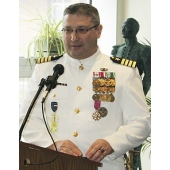SEDA STRATEGY AND MAIN GOALS
The strategy for this project is to create a step-change in medical
monitoring of the soldier by delivering on an aspirational goal of
achieving mobile and real time online monitoring of human medical
parameters and environment changes on the battlefield and provide the
Future Soldier market with the new product with
ergonomic design protected from external aggressive factors easy allows a
commanders to examine health parameters of the soldiers and change
tactics in real
time if necessary. The SEDA is compatible and will be integrated with most Future Soldier systems.
The main strategic goals of the project are:
- To create, produce and deploy the SEDA system
- To enter the world military market with innovative challenging technology
- To sell SEDA on the late stages
- To evolve system for civil usage and provide global mass-market with excellent products
- To divide SEDA on the few subsystems and make attractive products for different industries and personal usage
- To be leaders on the market
Our FIRST goal of the CrowdFunder Campaign: to get funds enough to develop the next stage of the SEDA project called USGS (see below).
Done already:
- Few prototypes to test some parts of the future system
- Innovative medical pneumatic bandage subsystem was developed and patented
- Mathematical model developed and proved by the scientists
- Several parts of software and hardware developed
- Technical specification of the SEDA prototype developed
Next Stage of the project.
The next stage is USGS - Uniform Sensor Grid Subsystem.
USGS
is the device integrated with the military uniform which detect and
localize Causes Explosive / Blast (CEB) and bullet injuries of the
soldier and define it severity. USGS consists of hardware part (USGSd)
integrated with the soldier’s military uniform and software application
(USGSs) installed on the commander’s PC. The weight of the system will
be not more than 0.2 kg and it will consider the anatomical
peculiarities of the soldier.
The uniqueness of the system is
in approach of providing the 99% true medical diagnosis of CEB and
bullet injuries in the real time on the moving patients in extreme
conditions. At the moment this approach is not using in the Future
Soldier world conception. Integrating this system with military uniform
we’re extremely increases survival chances of the wounded soldiers by
informing immediately about the CEB and bullet injury incidents and
providing medical recommendations to rescue team in the real time.
USGSd will include following array of sensors:
-
Sensor Grid will consist of the clusters with effective size of 150 mm.
Each cluster will include mutual accelerometer to detect the CEB and
bullet injuries by surface wave. This sensor will provide the system
with pressure-field analysis and define the severity of the injury. In
case of grid damaging the electrical resistance will measure to define
if there is a liquid between clusters. The time between the damage of
the grid and uniform get wet analyzing as well as additional parameter
of injury detection.
- PH sensor to detect if the liquid is blood
- Temperature sensor
- All clusters provide measurement results permanently to CPU in real time.
The
system will be protected from aggressive environment, e.g. snow, mud,
rain, etc. The range of working temperature will be +/- 50 C.
Operating Principles.
The
system should be a part of the uniform and manufactured in all
available sizes. Sensor network will be divided into separate
controllable elements, combined in a single system, a single computing
module, making joint information processing, accumulation of
information, decision making, transmission of telemetry data, the
transmission of the decision and indication of the decisions.
The
sensors will be united in clusters, the effective size of about 150 mm.
The cluster will include the mutual accelerometer (vibration-meter) for
determining the fact of injury and wound site by a surface wave, a grid
for determining the penetration of the gap control conductors, a
humidity sensor, the sensor of acidity of environment. Each cluster will
be a flexible, vapor transparent element in the form of chamomile
flowers. Superimposed on each other and touching the petals clusters of
this form will allow system to arrange full coverage of the body by
sensory elements to organize sustainable electrical contact for
transmitting power and telemetry information within the network.
The
accelerometer will be used to determine whether a gunshot wound by a
surface wave, the same sensor will detect the barotraumas and their
severity. Gunshot wound leads to the excitation of the waves on the body
surface with sufficiently large amplitude. The network of sensors by
joint processing of the high-frequency component from the accelerometers
may indicate the position of the wound site with high accuracy.
The
duplication of information about penetrating wound will be made on the
basis of the penetration sensor developed in the form of a grid, which
is damaged as a result of injury. The mesh can be damaged mechanically
in the process of operation, so it is made to duplicate and analyze data
from it goes together with other sensors. Torn fibers in the process of
operation not confirmed by other sensors and on this basis shall be
rejected by the Central processor of the cluster.
When the
fibers of the mesh rupture, then the system measures resistance between
the fibers of the mesh to indicate the presence of liquid impregnating
the mesh. The sharp change in resistance (wet) at the time after the
rupture of the fibers acts as additional information about the event.
The
mesh can be realized as winding of petals or in the form of a resistive
panel, for example, from a fabric with metallic threads.
An
additional sensor that signals the fact of injury will be a pH-tester.
It will signal if the liquid got on the sensor was blood.
USGSs
is the software application which will allow commander to monitor the
medical condition of the soldiers based on the USGSd working results.
The objectives of the USGS are
-
to develop and test the device and software in labs that will detect
the CEB and bullet injuries, allocate the place(s) of the injury(ies)
and define the level of severity
- to diagnosis the CEB and bullet injuries.
- provide information about each incident in case of few injuries.
- to develop and test the relevant software that will allow commander to monitor the medical condition of the soldiers
- to test the system in a field conditions.
Expected outcome:
-
The military uniform with integrated USGSd subsystem which will be able
to detect CEB and bullet injuries and define their location and
severity. The system will be protected from the aggressive environment.
-
The relevant USGSs software application of the system installed on the
commander’s PC. The software will provide medical diagnosis of wounded
soldier in case of injury and list of recommendations to rescue
operation that extremely increase the survival chances of wounded
soldier.
- The design documentation full enough to create the production sample on the next stage.
The budget of the USGS is USD 390, 000 (little more then 1% of the total budget).
TESTIMONIALS
Gary TABACH CAPTAIN(06)(R)
U.S. Navy
In consideration of my professional experience as Chief of Staff of NATO Military Liaison Mission, I have all reasons to declare that the successful development and deployment of this project will lead to the following results:
- additional defense of infantry soldiers on the battlefield
- advantages in medical triage of the wounded soldiers on the battlefield
- it will help to save lives of wounded fighters
- it will provide tactical advantages during the combat
- it will increase chances of success of military defense missions
- it will improve morale of the soldiers
- it will lead to new and important scientific results.
The results listed above are very important military advantages, which provide inestimable benefit in the Future Soldier concept development.
Seong K. Mun, PhD
Professor and Director of
VirginiaTech AIC
I have been engaged in combat casualty care and global health research and development projects for the US military health systems for 30 years. In consideration of my professional experience as Director of Arlington Innovation Center for Health Research I have all reasons to believe that the successful development and deployment of this project will lead to the following results:
- additional defense of infantry soldiers on the battlefield
- advantages in medical triage of the wounded soldiers on the battlefield
- help to save lives of wounded fighters
- provide tactical advantages during the combat
- increase success chances of military defense missions
- increase morale of the soldiers
-lead to new and important scientific results.
The results listed above are very important military advantages which provide critically important benefits in the Future Soldier concept development.I’m highly interested in the project’s success as it strictly correlate with 30 years of my own professional interests in military health and combat casualty care.
















